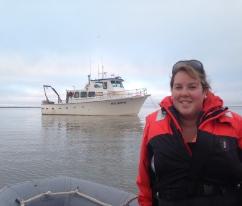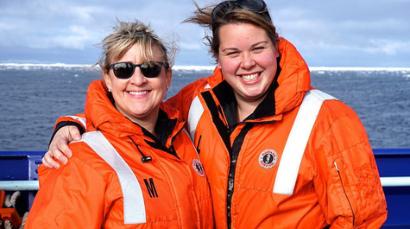Dr. Rachel Sipler

Rachel E. Sipler
Tier 2 Canada Research Chair in Marine Biogeochemistry
Assistant Professor

Email: resipler@mun.ca
Telephone: +1 709-864-3223
Address: Memorial University of Newfoundland
Department of Ocean Sciences
0 Marine Lab Road,
St. John’s, NL, A1C 5S7, Canada
Education
PhD Oceanography, Rutgers, the State University of New Jersey (2009)
BSc Biology, Salisbury University (2003)
BSc Environmental Science, University of Maryland Eastern Shore (2003)
Research Interests:
 My research is truly interdisciplinary and combines biogeochemistry, microbial physiology, and phytoplankton ecology to quantify how changes in the physical and chemical environment may impact marine microbial community composition, metabolic rates and aquatic food webs. Although the focus of my research has varied from constrained mechanistic studies investigating the response of specific phytoplankton species to a single organic matter source, to complex studies examining community scale microbial responses to an array of physical and chemical changes, the overarching goal of my research remains the same: to determine how marine phytoplankton and bacterial communities will respond to changes in their environment.
My research is truly interdisciplinary and combines biogeochemistry, microbial physiology, and phytoplankton ecology to quantify how changes in the physical and chemical environment may impact marine microbial community composition, metabolic rates and aquatic food webs. Although the focus of my research has varied from constrained mechanistic studies investigating the response of specific phytoplankton species to a single organic matter source, to complex studies examining community scale microbial responses to an array of physical and chemical changes, the overarching goal of my research remains the same: to determine how marine phytoplankton and bacterial communities will respond to changes in their environment.
My background is in biology and environmental science but I found that to truly understand the factors governing microbial communities I needed to understand the chemical properties of the system as well. I use traditional and cutting-edge techniques to explore and define the relationship between the chemistry of the water and the microbes that live within it. Phytoplankton are important because they form the base of the marine food web, produce the oxygen that we breathe and take up the carbon dioxide that we produce. They can also be important sentinels of environmental change. Changes in the amount of phytoplankton and types of species present can have significant consequences for food webs, biogeochemical fluxes, and climate feedbacks. The primary goals of my work are to 1) provide accurate information to incorporate into climate and ecosystem models, 2) Identify regions most or least at risk, 3) identify environmentally, socially, and economically reasonable solutions, and 4) inform management decisions by defining the most critical regions and chemical inputs.